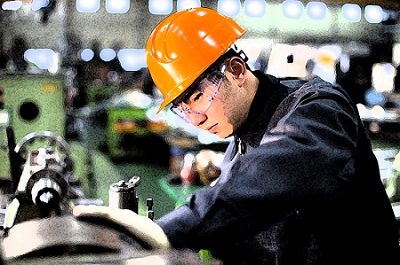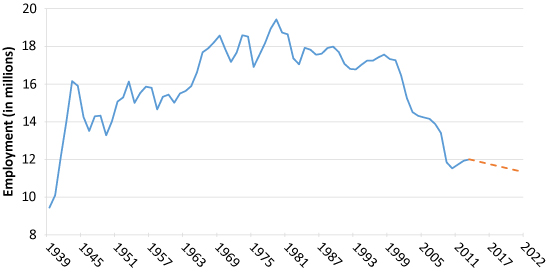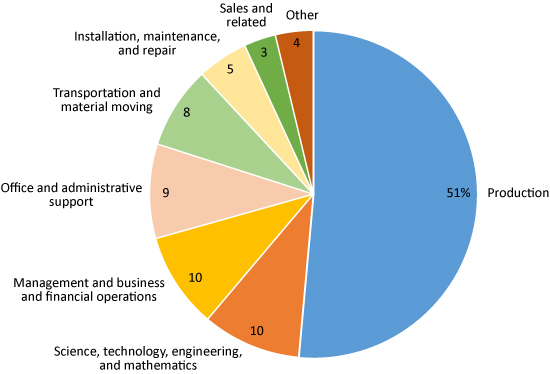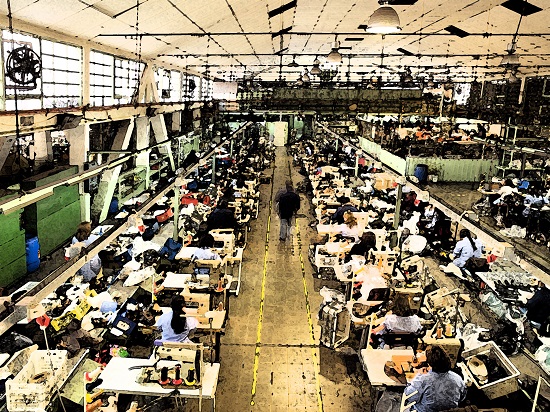An official website of the United States government
 United States Department of Labor
United States Department of Labor
| June 2014

“In what’s becoming a digital world, there’s still a demand for tangible goods,” says Brian Herrick of Baltimore, Maryland. “I like the tangible aspect of manufacturing. I like watching how things are made. You don’t get that in any other industry.”
Herrick should know. He has worked in several manufacturing industries and sees career potential for people who develop the right skills. “Manufacturing can be a great training ground, where you can learn how things are done and take things through production,” he says. “Once you develop that skill set, you gain competencies you can take anywhere.”
There were 264,000 job openings in manufacturing in March 2014, according to the U.S. Bureau of Labor Statistics (BLS). Although BLS projects employment to decline in most manufacturing industries between 2012 and 2022, future job openings are expected to result from the need to replace workers who are retiring. In addition, the pay is good: BLS data show that manufacturing workers often earn more overall than workers in other industries.
Industry experts say there’s a need for workers with the right skills in manufacturing. Employers are having trouble filling jobs for machinists and maintenance technicians, among other skilled trades. “We have manufacturers calling us weekly, wanting to hire our students,” says Dave Lynnes, president of a welding school in Fargo, North Dakota. Job openings are expected for welders and other production workers—but also for workers outside of production, such as biomedical engineers, dispatchers, and truck drivers.
This article is about jobs in manufacturing. The first section provides a brief history of U.S. manufacturing and summarizes how employment has changed and is projected to change. The second section describes occupations in manufacturing and suggests factors to consider in choosing manufacturing work. The third section explains which skills you need for a manufacturing career. The final section lists sources of more information.
Manufacturing has the most jobs of any goods-producing industry in the United States, more than 12 million of them in 2013. The manufacturing industry processes materials to make all kinds of products, including food, cars, and circuit boards. (See “Made in the U.S.A.”)
Many manufacturing jobs are still in large factories, plants, and mills. But bakeries, custom tailors, and other small businesses are part of manufacturing, too.
The story of manufacturing employment in the United States is one of growth, decline, and recovery. As chart 1 shows, manufacturing employment has fluctuated over the past 75 years and is expected to continue declining.
Chart 1: Manufacturing employment, 1939–2013 and projected 2022,
in millions of jobs

Note: BLS does not project specific data for each of the interim years to the 2022 projection point. These years are expressed as a dashed straight line. Source: U.S. Bureau of Labor Statistics, Current Employment Statistics survey (1939-2013 nonfarm wage and salary employment, not seasonally adjusted) and Employment Projections program (2022 projected employment).
Growth
BLS data show mostly growth in manufacturing employment from 1939 until 1979, when employment peaked at about 19.4 million jobs. Manufacturing growth was especially strong in the 1950s and 1960s as incomes rose along with demand for American-made products.
Employment generally held steady in manufacturing through the 1990s, even as technology began to lead to increased productivity. And goods manufactured outside the United States were starting to compete with those produced domestically.
Decline

Between 2000 and 2010, manufacturing employment declined by almost 6 million jobs—about one-third of its total. The low cost of producing goods abroad led many companies to move their manufacturing operations to other countries. And like many industries, manufacturing employment was hit hard during the recent recession (December 2007 through June 2009).
Recovery
The manufacturing industry began adding jobs in 2010, as the economy began recovering from the effects of the recession. But the nature of some of these jobs has changed, with fewer jobs on an assembly line and more jobs running computers or machines.
In addition, some manufacturers are moving production back to the United States as they factor in variables such as increasing labor costs abroad, the high cost of transporting goods, and the risks associated with foreign manufacturing. “Every week we’re hearing about a new company building a plant in the United States,” says Gardner Carrick of the Manufacturing Institute in Washington, D.C. “We’ve seen 4 straight years of job growth in manufacturing.”
But employment still has not returned to pre-recession levels, and it is unlikely to do so as technology has eliminated the need for some types of workers.
Projected changes
BLS projects manufacturing employment to lose about 550,000 jobs by 2022. In fact, of the 77 industries within manufacturing, only 19 are projected to add jobs. And most of these industries are not expected to reach their levels of employment from the previous decade. (See table 1.)
| Industry | Employment | ||
|---|---|---|---|
| 2012 | Projected 2022 | 2002 | |
|
Animal slaughtering and processing |
484,800 | 517,800 | 517,200 |
|
Motor vehicle parts manufacturing |
479,600 | 507,500 | 733,600 |
|
Machine shops; turned product; and screw, nut, and bolt manufacturing |
362,300 | 372,800 | 318,400 |
|
Architectural and structural metals manufacturing |
341,400 | 410,400 | 399,100 |
|
Pharmaceutical and medicine manufacturing |
270,800 | 283,800 | 291,300 |
|
Other fabricated metal product manufacturing(1) |
269,900 | 288,400 | 296,300 |
|
Household and institutional furniture and kitchen cabinet manufacturing |
216,500 | 222,400 | 402,400 |
|
Other wood product manufacturing(2) |
189,800 | 211,500 | 318,300 |
|
Other food manufacturing(3) |
174,300 | 177,400 | 150,900 |
|
Motor vehicle manufacturing |
168,000 | 176,200 | 265,400 |
|
Cement and concrete product manufacturing |
161,600 | 218,900 | 229,600 |
|
Coating, engraving, heat treating, and allied activities |
136,100 | 141,700 | 149,100 |
|
Motor vehicle body and trailer manufacturing |
125,400 | 135,400 | 152,200 |
|
Office furniture (including fixtures) manufacturing |
98,900 | 99,200 | 150,900 |
|
Boiler, tank, and shipping container manufacturing |
96,500 | 98,900 | 95,800 |
|
Sawmills and wood preservation |
84,300 | 93,500 | 120,900 |
|
Veneer, plywood, and engineered wood product manufacturing |
63,800 | 83,500 | 115,600 |
|
Clay product and refractory manufacturing |
40,600 | 44,400 | 71,600 |
|
Other transportation equipment manufacturing(4) |
32,500 | 33,800 | 38,800 |
|
Footnotes: |
|||
|
Source: U.S. Bureau of Labor Statistics, Employment Projections program |
|||
Although many of these industries are projected to have slower-than-average employment growth, a few are projected to increase at relatively fast rates. For example, employment growth in two industries—cement and concrete product manufacturing and veneer, plywood, and engineered wood product manufacturing—is expected to be about triple the average for all workers. Architectural and structural metals manufacturing employment is expected to nearly double.
The fastest growing manufacturing industries are directly related to construction, an industry that is projected to add many jobs over the 2012–22 decade. As construction activity expands, manufacturing industries that supply materials for construction projects are also expected to grow.
The manufacturing industry employs workers in hundreds of occupations. In May 2013, more than half of all manufacturing jobs were in production occupations: those involved primarily with making goods. (See chart 2.)
Chart 2: Distribution of manufacturing employment by occupational group, May 2013

Source: U.S. Bureau of Labor Statistics, Occupational Employment Statistics survey
Table 2 shows the occupations that BLS projects to add the most new jobs in manufacturing between 2012 and 2022. These occupations are expected to account for more than 126,000 new manufacturing jobs over the decade.
| Occupation | New jobs in manufacturing, projected 2012-22 | Job openings in all industries, projected 2012-22 |
|---|---|---|
|
Industrial machinery mechanics |
21,600 | 152,500 |
|
Metal and plastic computer-controlled machine tool operators |
19,100 | 59,600 |
|
Machinists |
18,500 | 125,900 |
|
Heavy and tractor-trailer truck drivers |
16,700 | 464,700 |
|
Welding, soldering, and brazing machine setters, operators, and tenders |
9,000 | 23,700 |
|
Meat, poultry, and fish cutters and trimmers |
7,200 | 49,000 |
|
Woodworking machine setters, operators, and tenders, except sawing |
6,000 | 9,600 |
|
Metal and plastic computer numerically controlled machine tool programmers |
5,500 | 13,500 |
|
Wood sawing machine setters, operators, and tenders |
5,300 | 16,600 |
|
Logisticians |
3,800 | 42,200 |
|
Structural metal fabricators and fitters |
3,800 | 38,200 |
|
Sheet metal workers |
3,300 | 48,900 |
|
Biomedical engineers |
2,300 | 10,100 |
|
Machinery maintenance workers |
2,100 | 21,100 |
|
Welders, cutters, solderers, and brazers |
2,100 | 108,500 |
|
Source: U.S. Bureau of Labor Statistics, Employment Projections program |
||
The manufacturing process
Although products are made differently, many of them go through a similar manufacturing process that involves a variety of workers. Smaller manufacturers may have one or two workers doing some or all of these production tasks. For example, the owner of a small candy shop may develop recipes, make candy, fix equipment, transport ingredients, manage the store, answer the phone, and sell products to customers.
The occupations highlighted in each worker group that follows are examples of some of the many types of manufacturing jobs.
Science, technology, engineering and mathematics workers are often involved at the earliest stages of manufacturing when they are creating or improving a product’s design. These workers may also help to design the machines, robots, and other technologies used in factories. As manufacturing innovation continues, a few of these occupations—including statisticians and biomedical engineers— are projected to add some jobs between 2012 and 2022.
Industrial engineers and mechanical engineers were among the highest paying occupations in manufacturing in May 2013. Median annual wages for these workers in manufacturing were $78,690 and $77,830, respectively—more than double the $35,080 median wage for all workers.

Production workers help to make a product according to its design specifications, doing tasks such as operating machinery, overseeing product quality, or packaging and preparing finished goods for shipping. Although many production tasks have been automated, some of the largest manufacturing occupations in May 2013 were in this group: first-line supervisors of production and operating workers; inspectors, testers, sorters, samplers, and weighers; machinists; and team assemblers.
In addition to having significant current employment, machinists are projected to add about 18,500 jobs in manufacturing between 2012 and 2022. Other occupations that are expected to increase manufacturing employment over the decade include metal and plastic computer-controlled machine tool operators (19,100 jobs) and welders (9,000 jobs).
Installation, maintenance, and repair workers keep the production equipment and machinery, as well as the facility itself, functioning properly. As a result of the increased use of automated processes, maintenance and repair work of machinery remains an important component of manufacturing.
Industrial machinery mechanics are projected to add about 21,600 manufacturing jobs—more than any other occupation in this group—by 2022. These jobs are expected to be in several manufacturing industries, including motor vehicle parts manufacturing, architectural and structural metals manufacturing, and pharmaceutical and medicine manufacturing.
Many goods are manufactured in the United States. The following list shows specific manufacturing industries, types of products that each industry makes, and the industry’s 2013 employment, according to BLS.
Chemicals. This industry makes products such as fertilizers, medicines, and paint and had about 793,000 jobs.
Computer and electronic products. Cell phones, fire alarm systems, and semiconductors are a few of the products this industry makes. There were about 1.1 million jobs in this industry.
Fabricated metal products. This industry makes products such as metal cookware; metal windows and doors; and screws, nuts, and bolts. It had about 1.4 million jobs.
Food. This industry makes products such as frozen fruits and vegetables, processed meats, and cheeses. With 1.5 million jobs, it was one of the largest manufacturing industries in terms of employment.
Machinery. Lawn and garden tractors, backhoes, and baseboard heating units are among the many products made by this industry, which had 1.1 million jobs.
Plastics and rubber products. This industry makes products such as plastic bottles, plastic plumbing fixtures, and rubber tires. It had 656,000 jobs.
Transportation equipment. Cars, trucks, and motor vehicle parts are some of the products this industry makes. It had 1.5 million jobs, making it one of the largest manufacturing industries in terms of employment.
Other. Other manufacturing industries include those that make primary metals, furniture, and wood products. These remaining 13 industries together had about 4 million jobs.
Transportation and material moving workers handle products and raw materials and help to get them from one location—such as a loading dock, shipping and receiving area, or warehouse—to another. The need for workers to do heavy lifting inside factories continues to diminish with the increased use of technology.
Hand laborers and freight, stock, and material movers was among the occupations with the largest manufacturing employment in May 2013. Another large occupation in this group, heavy and tractor-trailer truck drivers, is projected to add 16,700 jobs by 2022.
Management and business and financial operations workers plan and oversee manufacturing operations. New jobs for logisticians are projected in manufacturing between 2012 and 2022 as the industry focuses on efficiency.
Two management occupations in this group topped the list of highest paid workers in manufacturing in May 2013. Median annual wages in manufacturing were $108,800 for general and operations managers and $89,010 for industrial production managers.

Sales workers interact with existing and prospective customers to help get manufactured products to wholesalers, retailers, and consumers.
Wholesale and manufacturing sales representatives, except technical and scientific products, are among the highest paid manufacturing occupations. These workers had a median annual wage of $57,960 in May 2013.
Office and administrative support workers answer phones, process orders, and do clerical tasks.
One of the largest occupations in this group is shipping, receiving, and traffic clerks. Job growth for these workers, however, is expected to be limited as automation and the increased use of radiofrequency identification tags help workers track incoming and outgoing shipments more quickly and efficiently.
Other workers clean facilities, do electrical work, design product packaging, and assist in the manufacturing process in different ways.
Why work in manufacturing?
As with any industry, manufacturing has both advantages and disadvantages. Pay and benefits, the work environment, and other factors are worth considering when you're planning a career.
Pay and benefits. The median annual wage for all workers in manufacturing was $37,690 in May 2013, higher than the $35,080 median annual wage for all workers.
In some occupations, workers have higher wages in manufacturing than they do in other industries. For example, in May 2013, general maintenance and repair workers had a median annual wage of $42,080 in manufacturing, compared with $35,640 in all industries.
Starting salaries for some recent college graduates are higher in the manufacturing industry than in other industries, too. With an average starting salary of $56,841, for example, manufacturing was one of the highest paying industries for class of 2014 college graduates, according to the National Association of Colleges and Employers. This compares with an average starting salary of $45,473 for all class of 2014 college graduates.
Manufacturing employers spent more on employee benefits, such as health insurance or retirement plans, than did employers in some other industries. BLS data show that in March 2014, private industry employers spent $12.45 on benefits per hour worked for all manufacturing employees. By comparison, private industry employers spent $9.03 on benefits per hour worked for all employees.
Work environment. Manufacturing worksites often include large rooms with conveyor belts, assembly lines, robotic equipment, and areas for processing or storing materials and products. Most also have areas for office workers that resemble those in other businesses.
But the factory floor can be both a vast and fascinating place. “We use equipment that’s as big as a building,” says Amela O’Gorman, a customer service representative for a print manufacturer in Sussex, Wisconsin. “I’m always amazed to see the automation part of it when I’m walking through the production floor.”

Production facilities might be hot or noisy. In addition, some workers have tasks that are repetitious or require long periods of sitting or standing. “You’ve got to be on your feet for 8, 10, 12 hours a day in some jobs,” says Lynnes. “It can be very challenging in the summer months with the heat and humidity.”
The rate of nonfatal injuries and illnesses is higher for workers in manufacturing than for workers in other industries, BLS data show. Because of the potential risk of injury, workers in manufacturing facilities often must follow strict safety rules. For example, workers may be required to wear protective gloves, hair nets, or safety goggles.
But BLS data also show that in manufacturing, as in many industries, the rate of injuries and illnesses for workers has decreased substantially over the past decade. The industry's emphasis on safety defies an impression that many people have about manufacturing, workers say. “There’s a stereotype about manufacturing being a dirty, grimy environment, but that’s really not always the case,” says Phil Tulkoff, president of a food manufacturing company in Baltimore, Maryland. “Our facility is comfortable, safe, clean, and bright.”
Other factors. Manufacturing offers flexibility for people who want to work a nonstandard schedule. Some facilities run production lines in two or even three shifts, which may involve evening and nighttime work.
Workers say it's rewarding to observe the manufacturing process from start to finish. “I like seeing things come together,” says O’Gorman. “It’s kind of like a puzzle that you’re working on, from when the idea first comes up to the order being placed to when we’re actually producing the piece and then seeing the final product.”
Some workers seek jobs with a specific manufacturer because they like the product. “You have the opportunity to build stuff you’re passionate about,” says Brian Sweeney of the Maryland Manufacturing Extension Partnership in Columbia, Maryland. “I mean, how cool would it be to build the aircraft you see in a video game, or to make guitars? If you like using your hands and technology, and also using your brain, manufacturing is a chance to make a difference.”

One of the biggest draws for many manufacturing workers is that sense of pride they get from producing something others will use. “There’s a satisfaction in physically making something,” says Tulkoff. “I can walk into a grocery store or restaurant and see on the shelves the product that I helped to make.”
Manufacturing has opportunities for workers with a range of backgrounds. Some qualities and skills are often required. Workers also need a combination of education and training, which varies by occupation. For example, electrical and electronic equipment assemblers typically need a high school diploma or the equivalent plus on-the-job training of 1 month or less.
Jobs that require the least preparation have been affected most by technological changes in manufacturing. “Through the 2000s, most of the unskilled jobs got taken out of existence, because manufacturers could program machines to do those things,” says Carrick. “But people need to maintain or fix the machines. So manufacturers need fewer workers, but the workers they do need require higher level skills.”
Preparing for a manufacturing career also may include getting experience, earning licenses or certifications, and networking.
Qualities and skills
Manufacturing workers need to be able to cooperate as part of a team. They also need to be detail oriented, dependable, and adept at problem solving. Dexterity and mechanical or technical ability are important, too.
For many entry-level positions, requirements are even more basic. “It’s the simple stuff,” says Tulkoff, “like having the right attitude and being consistent about things like showing up for work on time.”
A willingness to learn and to be flexible about job tasks is also important. “Manufacturers are looking for people who take an interest in learning computer operation, quality control, and how to operate computer-based machinery,” says Sweeney. “Jobs today are not always ‘I do this every day.’ A lot of workers are expected to do different things in the plant.”
Workers may need some skills—such as basic math and computer aptitude—before starting in manufacturing. But they learn other skills in school or on the job.
Education
Manufacturing occupations are available for people at all education levels, from less than a high school diploma to a college degree.

Taking technical courses in high school is often a good way to start preparing for a career in manufacturing. “My high school tech classes really inspired me,” says O’Gorman. “When I went to apply for my first manufacturing job, I brought in all of the projects I had worked on in class. I could showcase some of the technical skills I had learned, and I think that helped me to get the job.”
You also may consider earning a certificate or a degree from a community college or technical school. But keep in mind that employers may focus less on your credentials and more on what you can do. “In some cases, a degree or certificate is helpful, but in others employers are looking more for applied skills,” says Sweeney. “Get in the workforce and learn what an employer is looking for.”
BLS designates occupations as typically requiring one of several levels of education for entry. Specific occupational requirements may vary, even from one job or employer to another. The BLS designation is for what is most typical according to qualitative and quantitative research.
Accompanying tables show employment and wages for selected occupations with at least 1 percent of manufacturing employment in May 2013, by typical level of education needed for entry. Other typical entry requirements, such as on-the-job training or work experience in a related occupation, are also indicated. Although employment is projected to decline in many of these occupations, the need to replace workers who retire is expected to create some opportunities.
Less than a high school diploma. Manufacturing has jobs in some occupations that workers can enter without a high school diploma. Several of the occupations in table 3, such as sewing machine operators, are in production. Others, including hand packers and packagers, are involved in transporting and moving materials and finished products.
| Occupation | Employment | Median annual wage | On-the-job training |
|---|---|---|---|
|
Hand laborers and freight, stock, and material movers |
274,670 | $27,340 | Short term |
|
Production workers' helpers |
255,680 | 24,610 | Short term |
|
Hand packers and packagers |
178,390 | 22,840 | Short term |
|
Industrial truck and tractor operators |
159,210 | 31,980 | Short term |
|
Meat, poultry, and fish cutters and trimmers |
126,270 | 23,440 | Short term |
|
Sewing machine operators |
123,420 | 21,230 | Short term |
|
Note: These occupations do not require work experience in a related occupation. |
|||
High school diploma or the equivalent. There are many occupations in manufacturing that typically require a high school diploma or successful passage of a high school equivalency exam.
The occupations in table 4 are dispersed among many groups, including sales; office and administrative support; installation, maintenance, and repair; and production.
| Occupation | Employment | Median annual wage | On-the-job training |
|---|---|---|---|
|
Team assemblers |
790,480 | $30,200 | Moderate term |
|
Inspectors, testers, sorters, samplers, and weighers |
317,070 | 35,410 | Moderate term |
|
Machinists |
316,050 | 39,570 | Long term |
|
Packaging and filling machine operators and tenders |
249,540 | 28,290 | Moderate term |
|
Welders, cutters, solderers, and brazers |
228,350 | 35,700 | Moderate term |
|
Wholesale and manufacturing sales representatives, except technical and scientific products |
215,650 | 57,960 | Moderate term |
|
General maintenance and repair workers |
194,200 | 42,080 | Long term |
|
Shipping, receiving, and traffic clerks |
186,930 | 31,550 | Short term |
|
Industrial machinery mechanics |
173,020 | 48,210 | Long term |
|
Electrical and electronic equipment assemblers |
168,590 | 29,810 | Short term |
|
Metal and plastic cutting, punching, and press machine setters, operators, and tenders |
158,240 | 30,770 | Moderate term |
|
General office clerks |
147,350 | 29,700 | Short term |
|
Customer service representatives |
142,630 | 37,290 | Short term |
|
Metal and plastic computer-controlled machine tool operators |
137,650 | 35,900 | Moderate term |
|
Printing press operators |
124,270 | 35,150 | Moderate term |
|
Note: These occupations do not require work experience in a related occupation. |
|||
Certificate or other postsecondary non-degree award. Certificates (which differ from certifications issued by professional organizations or certifying bodies) and other postsecondary non-degree awards are given by educational institutions for completing a formal program after high school that may last from a few weeks to 2 years.
Workers in two manufacturing occupations shown in table 5—first-line supervisors of production and operating workers and heavy and tractor-trailer truck drivers—typically need a certificate or other type of postsecondary non-degree award.
| Occupation | Employment | Median annual wage | On-the-job training |
|---|---|---|---|
|
First-line supervisors of production and operating workers(1) |
421,580 | $55,010 | None |
|
Heavy and tractor-trailer truck drivers(2) |
123,720 | 36,750 | Short term |
|
Footnotes: |
|||
|
Source: U.S. Bureau of Labor Statistics, Occupational Employment Statistics survey (employment and wages), Employment Projections program (education and training) |
|||
| Occupation | Employment | Median annual wage | On-the-job training |
|---|---|---|---|
|
General and operations managers(1) |
210,240 | $108,800 | None |
|
Industrial engineers(2) |
166,370 | 78,690 | None |
|
Industrial production managers(3) |
133,860 | 89,010 | None |
|
Mechanical engineers(2) |
131,700 | 77,830 | None |
|
Footnotes: |
|||
|
Source: U.S. Bureau of Labor Statistics, Occupational Employment Statistics survey (employment and wages), Employment Projections program (education and training). *Occupations with 1 percent or more of manufacturing employment are shown. Other occupations in the industry that typically require a bachelor's degree include accountants and auditors, logisticians, and biomedical engineers. |
|||
Other degrees. No occupations that typically require an associate’s, master's, or doctoral or professional degree for entry met the cutoff for this article of having 1 percent of manufacturing employment. This does not mean that occupations with these levels of education are not in manufacturing, however.
For example, occupations in manufacturing that typically require an associate’s degree include industrial engineering technicians, chemical technicians, and semiconductor processors. Master's degree-level occupations in manufacturing include orthotists and prosthetists.
Occupations in manufacturing that typically require a doctoral or professional degree include medical scientists, except epidemiologists; biochemists and biophysicists; and computer and information research scientists.
Training
Training on the job is one of the most important ways for workers to become competent at many occupations in manufacturing. This training often happens informally, as workers learn from more experienced workers. More structured training sometimes is offered as well.
Through on-the-job training, workers get instruction in the tasks specific to their occupations—but the learning often comes through doing. “It’s that hands-on experience that makes things click,” says O’Gorman. “It takes time, patience, and practice.”
BLS identifies the amount of training that workers typically need to become fully competent in an occupation. Occupations receive designations indicating if they typically need no on-the-job training; short-, moderate-, or long-term- on-the-job training; an internships or residency; or an apprenticeship. Such training is occupation-specific rather than job-specific: The skills learned in one job can be transferred to another job in the same occupation.
None. This designation indicates that no additional occupation-specific training or preparation is typically required for workers to attain competency. Industrial engineers, mechanical engineers, and general and operations managers are some of the occupations that do not typically require occupation-specific on-the-job training.
Short term. Occupations requiring short-term on-the-job training are defined as those in which workers typically learn the skills they need with 1 month or less of informal training or experience in the job. Among the occupations that typically need short-term on-the-job training are customer service representatives, sewing machine operators, and production workers’ helpers.

Moderate term. In occupations requiring moderate-term on-the-job training, workers typically need more than 1 month and up to 12 months of combined on-the-job experience and informal training to attain competency. Examples include team assemblers, welders, and computer-controlled machine tool operators.
Long term. To become competent in occupations requiring long-term on-the-job training, workers typically need more than 12 months of on-the-job training or, alternatively, combined work experience and formal classroom instruction. General maintenance and repair workers, industrial machinery mechanics, and machinists are among the occupations designated as needing this level of training.
Internship/residency. An internship or residency involves training under supervision in a professional setting. This type of training is commonly required for state licensure or certification in fields such as medicine and architecture.
Although rarely required to enter occupations in manufacturing, a few occupations with jobs in the industry, such as industrial-organizational psychologists, may need this type of training.
Apprenticeship. An apprenticeship is a form of training that involves paid work and related technical instruction. Occupations that typically need training in the form of an apprenticeship include sheet metal workers, electricians, and millwrights.
BLS designates occupations as needing an apprenticeship if it is part of the typical path to entry and competency. There are occupations with apprenticeships available that are not designated as such by BLS.
Experience and more
To qualify for an entry-level position in some occupations, you may need either work experience in a related occupation, a professional credential, or both. In other occupations, experience is useful even if it isn’t required. And networking is helpful for getting a foot in the factory door.
Experience. BLS designates whether occupations typically require work experience in a related occupation. For example, industrial production managers typically need 5 or more years of work experience in a related supervisory occupation.
Regardless of whether it is required, however, having manufacturing experience is often helpful before entering these occupations. Summer or part-time jobs and internships are ways to discover what you like about working in manufacturing—or whether it’s for you.
Credentials. In some occupations, it may be important, or even necessary, to have state licensure or certification from a professional association or credentialing body. For example, machinists who complete certification programs may have better job opportunities than those who don't. And heavy and tractor-trailer truck drivers often need a commercial driver’s license before being hired.
Networking. Networking can help you to learn more about the specifics of what employers are looking for. It might even provide clues about which manufacturers are hiring.
Joining professional associations is one way to make contacts. Opportunities to network are available to students, too, and they usually offer a social outlet. For example, O’Gorman was involved with SkillsUSA, a national skills competition, while in college. “I got to meet so many new people,” she says, “both students who were passionate about printing and manufacturing like me and experts who work in the industry.”
Building a network can start anywhere. If you don't have personal contacts, consider going straight to the source of employment. “Try to go visit one of your local manufacturers,” says Carrick. “They are in every state, in almost every small town or city, and most are willing to show people what they do.”
O’Gorman credits networking with helping her to land a job in a difficult market. “When I graduated from college during the recession, there weren’t many jobs available, but my network helped me to get started in my career,” she says. “They knew where the opportunities might be and pointed me in the right direction.”
You can learn more about the occupations in this article, and hundreds of others, in the Occupational Outlook Handbook. Public libraries also have career resources and business directories to help identify local manufacturers.
Other Career Outlook articles related to manufacturing include
• “You’re a what? Roastmaster”
• “Charting the projections: 2012–22”
• “Apprenticeship: Earn while you learn”
• “Careers in organic food production”
This article uses data from various BLS sources. Find the latest data on manufacturing by visiting its page for BLS Industries at a Glance.
For information and initiatives related to the skills gap in manufacturing, contact:
The Manufacturing Institute
733 10th Street, NW Suite 700
Washington, DC 20001
(202) 637-3426
SkillsUSA is a national organization for skills training in high school and college career and technical education programs. To learn about its programs, scholarships, competitions, and more, contact
SkillsUSA
14001 SkillsUSA Way
Leesburg, VA 20176
(703) 777-8810
Elka Torpey, "Got skills? Think manufacturing," Career Outlook, U.S. Bureau of Labor Statistics, June 2014.